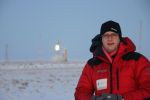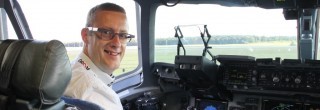Baikonur Cosmodrome is the largest space port in the world. Thousands of launches have taken place from here, making it the true birth place of space exploration. Worldwide it is only rivaled by Kennedy Space Center in the United States. Many ‘firsts’ in space were constructed and launched from Baikonur, starting with Sputnik, the world’s first satellite, in 1957. The first person in space, Yuri Gagarin, launched from here in 1961, as did the first woman in space, Valentina Tereshkova, in 1963. Continue reading
Russia
Baikonur Cosmodrome – The Last Place on Earth
 Baikonur Cosmodrome. Located literally in the middle of nowhere in Central Asia. Hardly an attractive or easy place to travel to. Yet on the bucketlist of most of my spacegeek-friends on social media. I have written a few posts on this place already, most recently writing a travel guide to the city of Baikonur. This post describes Baikonur Cosmodrome from the perspective of its most important visitors. For space travelers Baikonur truly is the Last Place on Earth. Next stop: Space! Continue reading
Baikonur Cosmodrome. Located literally in the middle of nowhere in Central Asia. Hardly an attractive or easy place to travel to. Yet on the bucketlist of most of my spacegeek-friends on social media. I have written a few posts on this place already, most recently writing a travel guide to the city of Baikonur. This post describes Baikonur Cosmodrome from the perspective of its most important visitors. For space travelers Baikonur truly is the Last Place on Earth. Next stop: Space! Continue reading
Space City Baikonur – a travel guide
 There are a handful of places in the world that are on top of every space enthusiast’s bucket list. For the true space historian Baikonur has the top spot. This is the town where human’s voyage into space truly began, with the launch of the world’s first satellite, Sputnik 1 in 1957, quickly followed by the launch of the first man in space, Yuri Gagarin in 1961. If these two historic facts are not enough to make you want to visit, then the fact that this is the only place in the world (apart from China) where humans are being launched into space today, should convince you. Baikonur embodies the great past of spaceflight, but still counts as the most important space port in the world today, 59 years after construction began. Continue reading
There are a handful of places in the world that are on top of every space enthusiast’s bucket list. For the true space historian Baikonur has the top spot. This is the town where human’s voyage into space truly began, with the launch of the world’s first satellite, Sputnik 1 in 1957, quickly followed by the launch of the first man in space, Yuri Gagarin in 1961. If these two historic facts are not enough to make you want to visit, then the fact that this is the only place in the world (apart from China) where humans are being launched into space today, should convince you. Baikonur embodies the great past of spaceflight, but still counts as the most important space port in the world today, 59 years after construction began. Continue reading
The Russians always launch
Extreme weather no objection for Soyuz
 Circumstances at Baikonur were perfect when cosmonaut André Kuipers was launched into space last December: Temperatures around -30 degrees Centigrade and crystal clear skies. Why do the Russians continue using their remote base in the middle of Kazachstan’s endless steppe? Continue reading
Circumstances at Baikonur were perfect when cosmonaut André Kuipers was launched into space last December: Temperatures around -30 degrees Centigrade and crystal clear skies. Why do the Russians continue using their remote base in the middle of Kazachstan’s endless steppe? Continue reading
Baikonur blog – launch day!
More launch pads, SoyuzTweetup and a Launch!
 Baikonur, 21 December 2011 – Finally. Today is the day we have been living up to for a long time. The launch of Soyuz TMA-03M, with ‘the’ Dutch astronaut André Kuipers on board. It is still dark outside when I wake up around 8 o’clock. Today our program consists of two major visits. First we will go to the furthest launch location at the cosmodrome: the Proton launch facility. Then we have some time in the city before going to launch pad 1 for the launch in the early evening.
Baikonur, 21 December 2011 – Finally. Today is the day we have been living up to for a long time. The launch of Soyuz TMA-03M, with ‘the’ Dutch astronaut André Kuipers on board. It is still dark outside when I wake up around 8 o’clock. Today our program consists of two major visits. First we will go to the furthest launch location at the cosmodrome: the Proton launch facility. Then we have some time in the city before going to launch pad 1 for the launch in the early evening.
Baikonur blog – space history and more space history
Launch Pads, Shuttles and Public Outreach
 Baikonur, 20 December 2011 – After breakfast at our hotel we are greeted again by our guide Elena and driver Said. The uncomfortable van is heated up and waiting for us, this time with the Tsenki security lady already inside. When we leave she hands us two “cosmodrome rules” forms and asks us to sign a list with our names on it. No idea why this was not needed yesterday, but we happily comply. We are waved past the city exit checkpoint, and easily pass the cosmodrome entrance checkpoint. Then again a long empty road to the cosmodrome facilities. This time we go straight on, towards the far end of this middle section at site 250. This launch pad is no longer active, but of great historical importance, as it was built for the Russian space shuttle Buran in the 1980’s.
Baikonur, 20 December 2011 – After breakfast at our hotel we are greeted again by our guide Elena and driver Said. The uncomfortable van is heated up and waiting for us, this time with the Tsenki security lady already inside. When we leave she hands us two “cosmodrome rules” forms and asks us to sign a list with our names on it. No idea why this was not needed yesterday, but we happily comply. We are waved past the city exit checkpoint, and easily pass the cosmodrome entrance checkpoint. Then again a long empty road to the cosmodrome facilities. This time we go straight on, towards the far end of this middle section at site 250. This launch pad is no longer active, but of great historical importance, as it was built for the Russian space shuttle Buran in the 1980’s.
Continue reading
Baikonur blog – A Soviet city
A week in one day
 Baikonur, 19 December 2011 – At the moment I write this I have spent 28 hours in Baikonur. That is 26 more than when I wrote my blog yesterday. But it feels like more, way more. A day with a full schedule and weird coincidences, which can turn an ordinary trip into a great adventure! It definitely turned these 26 hours into an experience that feels like a week. It started with the alarm clock at 7:30 this morning… Continue reading
Baikonur, 19 December 2011 – At the moment I write this I have spent 28 hours in Baikonur. That is 26 more than when I wrote my blog yesterday. But it feels like more, way more. A day with a full schedule and weird coincidences, which can turn an ordinary trip into a great adventure! It definitely turned these 26 hours into an experience that feels like a week. It started with the alarm clock at 7:30 this morning… Continue reading

